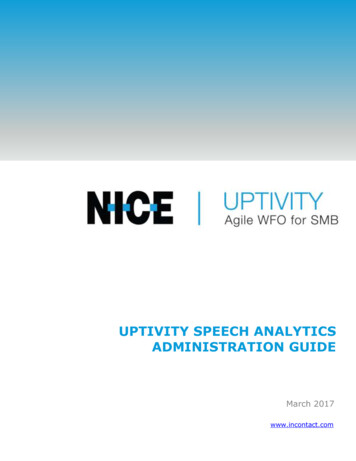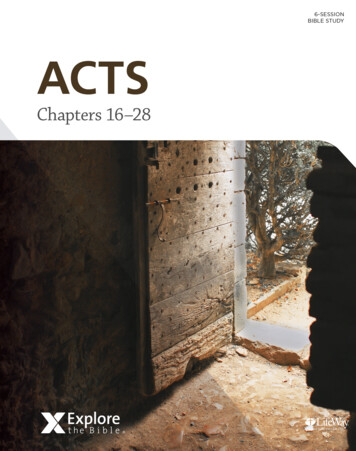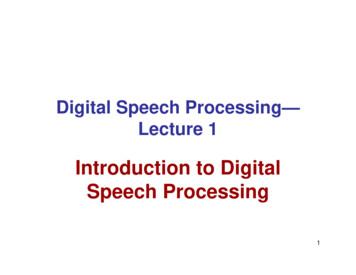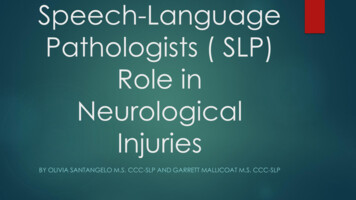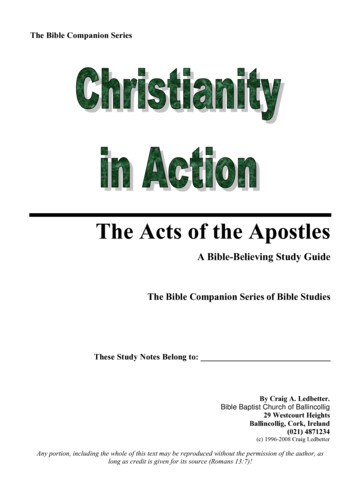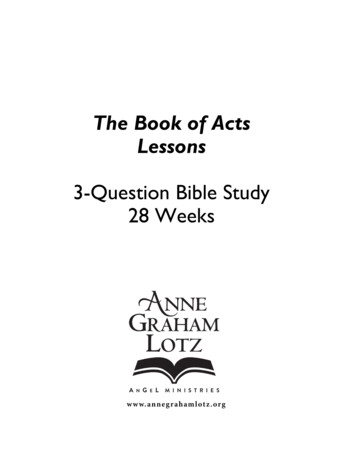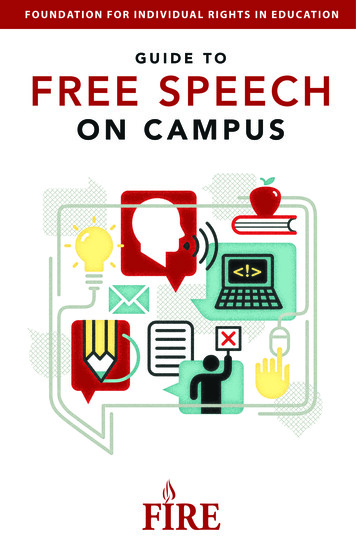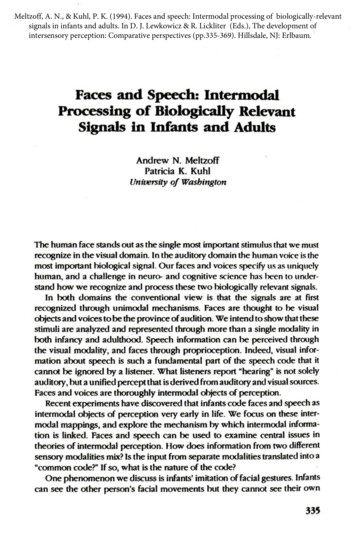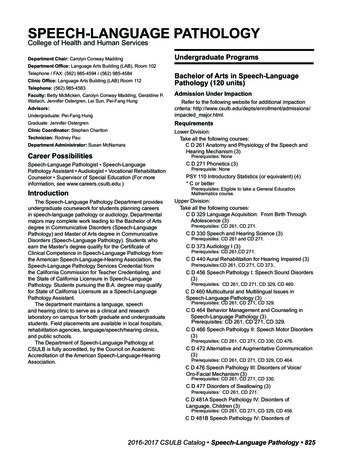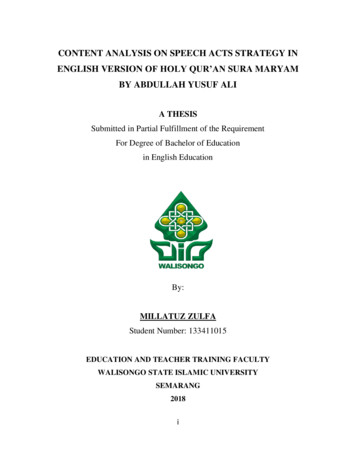
Transcription
CONTENT ANALYSIS ON SPEECH ACTS STRATEGY INENGLISH VERSION OF HOLY QUR’AN SURA MARYAMBY ABDULLAH YUSUF ALIA THESISSubmitted in Partial Fulfillment of the RequirementFor Degree of Bachelor of Educationin English EducationBy:MILLATUZ ZULFAStudent Number: 133411015EDUCATION AND TEACHER TRAINING FACULTYWALISONGO STATE ISLAMIC UNIVERSITYSEMARANG2018i
KEMENTERIAN AGAMAUNIVERSITAS ISLAM NEGERI WALISONGOFAKULTAS ILMU TARBIYAH DAN KEGURUANJl. Prof. Dr. Hamka Kampus II Ngaliyan Telp. 7601295 Fax.7615387 Semarang 50185THESIS STATEMENTI am, the student with following identity:Name: Millatuz ZulfaNIM: 133411015Department: EducationField of Study : English Language EducationCertify that the thesis untitled:CONTENT ANALYSIS ON SPEECH ACTS STRATEGY INENGLISH VERSION OF HOLY QUR’AN SURA MARYAMBY ABDULLAH YUSUF ALIis definitely my own work. I am completely responsible for thecontent of this thesis. Other researcher‟s opinions or findingsincluded in the thesis are quoted or cited in accordance with ethicalstandards.Semarang, 17th of May 2018The Writer,Millatuz ZulfaNIM. 133411015ii
KEMENTERIAN AGAMAUNIVERSITAS ISLAM NEGERI WALISONGOFAKULTAS ILMU TARBIYAH DAN KEGURUANJl. Prof. Dr. Hamka Kampus II Ngaliyan Telp. 7601295 Fax.7615387 Semarang 50185RATIFICATIONThesis with the following identity:Title: Content Analysis On Speech Acts Strategy In EnglishVersion of Holy Qur‟an Sura Maryam By Abdullah Yusuf AliName: Millatuz ZulfaNIM: 133411015Departmentt: English Language Educationhad been ratified by the Board of Examiners in Education and Teacher TrainingFaculty of Walisongo State Islamic University and can be received as one of anyrequirement for gaining the Bachelor Degree in English Language Education.Semarang, 24th of july 2018THE BOARD OF EXAMINERSChair Person,Secretary,Dr. H. Ikhrom, M.Ag.NIP. 19650329 199403 1 002Nadiah Ma‟mun, M.Pd.NIP. 19781103 200701 2 016Examiner 1,Examiner II,Sayyidatul Fadlilah, S.Pd.I., M.Pd.NIP. 19810908 200710 2 001Dra. Hj. Siti Mariam, M.Pd.NIP. 19650727 199203 2 002Advisors,Advisor I,Advisor II,Muhammad. Nafi Annury, M.Pd.Hum.NIP.19780719 20050 1 007Dr. H. Ahmad Ismail, MA. M.NIP. 19750705 200501 1001iii
ADVISOR APPROVALSemarang, 17th of May 2018Dear Sir,Dean of Education and Teacher Training FacultyWalisongo State Universitydi SemarangAssalamu’alaikum wr. wb.Aftercorrecting it to whatever extent necessary, we state that the finalproject belongs to student as bellow:Name of StudentStudent NumberDepartementTitle: Millatuz Zulfa: 133411015: English Language Education: CONTENT ANALYSIS ON SPEECHACTS STRATEGY IN ENGLISHVERSION OF HOLY QUR’AN SURAMARYAM BY ABDULLAH YUSUF ALIis ready to be submitted to Education and Teacher Training FacultyWalisongo State Islamic University to be examined at MunaqosyahSession.Wassalamu’alaikum wr. wb.Advisor IMuhammad Nafi Annury, M.Pd.NIP. 19780719 200501 1007iv
ADVISOR APPROVALSemarang, 17th of May 2018Dear Sir,Dean of Education and Teacher Training FacultyWalisongo State Universitydi SemarangAssalamu’alaikum wr. wb.Aftercorrecting it to whatever extent necessary, we state that the finalproject belongs to student as bellow:Name of StudentStudent NumberDepartementTitle: Millatuz Zulfa: 133411015: English Language Education: CONTENT ANALYSIS ON SPEECHACTS STRATEGY IN ENGLISHVERSION OF HOLY QUR’AN SURAMARYAM BY ABDULLAH YUSUF ALIis ready to be submitted to Education and Teacher Training FacultyWalisongo State Islamic University to be examined at MunaqosyahSession.Wassalamu’alaikum wr. wb.Advisor IIDr. H. Ahmad Ismail, MA, M. HumNIP. 19670208 199703 1 001v
ABSTRACTTitle: Content Analysis on Speech Acts Strategy inEnglish Version of Holy Qur‟an Sura Maryamby Abdullah Yusuf AliName: Millatuz ZulfaStudent Number: 133411015This study aims to find out the using of speech acts‟ types andstrategy‟s based on Searl theory on English version of Holy Qur‟an SuraMaryam by Abdullah Yusuf Ali‟s Translation, especially on the storyabout Maryam and her son; prophet Isa, start from verse 16 to 40. Thisstudy was library research and designed as descriptive qualitative study.The data was conducted by documentation technique from Yusuf Ali‟sversion (1997) in The Meaning of the Holy Qur'an: New ed. with rev.translation. commentary. and newly compiled index. The writer analyzedthe data using content analysis. The result of this study showed that:firstly, Only four types of speech act functions found in the data,representative, directive, expressive, commisive and the writer did notfound declaration types in the data analyzed. The highest percentage isrepresentative up to 56% (14) data with some types, such as, informing,stating, asserting, recounting, explaining, blessing, clarifying. Then,directive 32% (8) data with various types such as asking, commanding,ordering, prohibiting and praying. In the third position was expressive inthe form of complaining and complementing 8% (2) data. The last wascommisive in the form of promising, only 4% (1) datum from the total ofdata analysis (25 verses). Secondly, the data used direct and indirectstrategy. The dominant percentage of speech acts strategy is directspeech act 88% (22). It was in 4 types of sentences, declarative,imperative, interrogative and exclamation which appropiate with itfunction. Declarative has the fuction as statement or assertion, imperativehas the function of request, order or command, interrogative has thefunction as asking question, and exclamation has the function as expressvi
a feeling. While there are only 12% 9 (3) data used indirect speech act,such as: the sentence in declarative form but it has function to asking andrequesting, and interrogative form but functioning as ordering.Keywords: Content Analysis, Speech Act, Strategy, EnglishVersion,Holy Qur‟anvii
TRANSLITERASI ARAB-LATINPenulisan transliterasi huruf-huruf Arab Latin dalam skripsi iniberpedoman pada SKB Menteri Agama dan Menteri Pendidikandan Kebudayaan R.I. Nomor: 0543b/U/1987. Penyimpanganpenulisan kata sandang [al-] disengaja secara konsisten agar sesuaiteks Arabnya. ا ب ab ط ظ ṭẓ ت ث ج ح tḥ ع غ ف ق „gfq خ kh ك k د ذ ر ز dżrz ل م ن و lmNW س ش ص ssy ه ء ي H Y ض Bacaan Madd:ḍṡjṣBacaan DiftongĀ a panjangau ْ اَو ῑ i panjangai ْ آى ū u panjangiy ْ اِى viii
DEDICATIONThis Thesis dedicate to: The writer‟s beloved parents: Father and mother (AyahMasykur Munawar and Ibu Nur Fadlilah) who always giveher spiritual and financial support during the time of studyand as a reason for finishing this thesis, Her beloved brother and five little sisters: Mas Adib, Dina,Najma, Karim, Ovi and Aida, thaks for never ending prayand love for her. Honorable, Dr. Mohammad Nasih, M.Si as the writer‟steacher who always inspirates and motivates the writer. All of the members of PG-TK Islam Mellatena and MIS2013 who have become the second family in the place thewriter study, thanks for the support and guidance till shegraduated. The writer friends: Titin, Layyina, Zila, Novi, Eva, Umi,Nida‟ and friends, thanks for always supporting the writerto finish this thesis.ix
ACKNOWLEDGEMENTForemost, all praises to Allah Almighty, who has given strengthand true spirit so this thesis comes to completion. On this occasion, thewriter would like to thank all people who have helped and inspired her infinishing this thesis entitled “Content Analysis on Speech Acts Strategy inEnglish Version of Holy Qur’an Sura Maryam by Abdullah Yusuf Ali.”This thesis reflects the contributions of several people who have beeninvolved in the writer‟s long process to finish her thesis. The writerespecially would like to express her sincere gratitude to the followinghelpful people.1. Dr. H. Raharjo, M. Ed. St, the dean ofEducation TeacherTraining Faculty.2. Dr. H. Ikhrom, M. Ag, the head of English Language Education.3. Muhammad Nafi Annury, M.Pd as the first advisor andDr.H.Ahmad Ismail, M.Ag, M.Hum as the second advisor4. Shofa Muthohar as the writer‟s guardian from the first perioduntil the end, thanks for support and guidance to finishing thisthesis.5. Prof. Sri Suhandjati Sukri and Dr. Mohammad Nasih, M.Si,thank you for giving the best place during the writer were inSemarang.6. All of the writer‟s family members, she truly thank you forsupporting and praying in every time for her success.7. All of member of Monash Institute 2013-2017, that give thewriter big support to keep long life education.x
8. All of member of PG-TK ISLAM Mellatena, Abi Muharrom,Bunda Yuli, Bunda Rohmah, Bunda Faizah and Bunda Ulfa, andBunda Solikhah who always supprort each other to fineshed ourthesis. Thanks a lot for Hohe, Syauqia and friends for beingentertain the writer.9. All of friends in PBI-A 2013, all members of PPL SMAN 12,KKN POSKO 18 and PONPES Darul Qalam 2, thanks a lot ofassistance and cooperation.10. Those who can not be mentioned one by one, the writer can onlysay thanks for the contributions and assistances.The writer realized that this thesis is still far from being perfect.She will be glad to receive criticism and suggestion to make thisthesis better. She asks apology to all people to whom she has mademistakes during the study. Finally, the writer expects that this thesisis useful to the writer and everyone who is interested in pragmaticsstudy. Aamiin.Semarang, 17th of May 2018The writerMillatuz ZulfaStudent Number 133411015xi
MOTTO“ .” .“Let Them fear Allah and speak words appropriate(comfort)”1”ُ “ َخْي ُرُك ْم َم ْن تَ َعلَّ َم الْ ُق ْرآ َن َو َعلَّ َمه “The best of you are those who learn the Quran and teach it.”21A.Yusuf Ali, the Holy Qur‟an Text, Translation and Commentary,(USA: Amana Corp, 1983), p. 1862Ibnu Hajar Al-Asyqalani, Fath Al-Baari, Trans. Amiruddin, (Jakarta:Pustaka Azzam, 2015), p. 897xii
TABLE OF CONTENTSCOVER .iTHESIS STATEMENT .iiRATIFICATION .iiiADVISOR APPROVAL .ivABSTRACT .viTRANSLITERATION .viiiDEDICATION . .ixACKNOWLEDGMENT .xMOTTO .xiiTABLE OF CONTENT .xiiiLIST OF TABLE .xviABBREVIATIONS .xviiCHAPTER I: INTRODUCTIONA. Background of the Study .1B. Question of the Study .9C. Objectives of the Study .9D. Significances of the Study .9E. Previous Study .10F. Method of the Study .191. Research Design .192. Sources Data .20xiii
3. Scope of The Study .224. Technique of Data Collection .235. Technique of Data Analysis .26CHAPTER II: SPEECH ACT THEORYA. Pragmatics .29B. Speech Act .35C. Speech Acts Strategy .40CHAPTER III: BIOGRAPHY OF ABDULLAH YUSUF ALIAND GENERAL OVER VIEW OF HOLY QUR’AN SURAMARYAMA. Biography of Abdullah Yusuf Ali .45B. General Over View of Holy Qur‟an SuraMaryam .47CHAPTER IV: CONTENT ANALYSIS OF SPEECH ACTSTRATEGY IN YUSUF ALI’S VERSION OF HOLYQUR’AN VERSION SURA MARYAMA. Analysis the Types of Speech Acts Functionused in English Version of Holy Qur‟an suraMaryam by Abdullah Yusuf Ali .57B. Analysis the types of Speech Acts Strategyused in English Version of Holy Qur‟an suraMaryam by Abdullah Yusuf Ali .xiv67
C. Discussion .77CHAPTER V: CONCLUSIONS AND RECOMMENDATIONA. Conclusions .85B. Recommendations .86REFERENCESAPPENDICESxv
LIST OF TABLETable 1.1 The table of Speech acts classification by SearlTable 4.1 Data Finding of Types of Speech Act FunctionsTable 4.2 Data Finding of Speech Act Strategyxvi
ABBREVIATIONSDSADirect Speech ActISAIndirect Speech xclamationxvii
CHAPTER IINTRODUCTIONIn this chapter, the writer discusses the introduction of thestudy. This chapter consists of six parts. They are background of thestudy, questions of the study, objectives of the study, significances ofthe study, previous study and method of the Study.A. Background of the StudyThe speech act theory is usually studied under thebroad rubric of pragmatics, it can be defined as the study ofthe ability of language users to pair sentences with thecontexts in which they would be appropriate.1 The termspeech act was coined by the linguistic philosopher, Austinand developed by Searl.2 Austin defined speech act asactions performed in saying something, he also stated thatsaying something can be detected as doing pretation is appropriate with the general purpose of thespeaker utterances. So the study of speech act is important.1Stephen C. Levinson, Pragmatics, (Cambridge: CambridgeUniversity Press, 1983), p. 24.2David Nunan, Introducing Discourse Analysis, p. 65.3Gorge Yule, Pragmatics, (Oxford: Oxford University Press, 1996),p. 47.1
Nowdays, the research related to the pragmaticsstudy is interested, there are some objects of the reasearch,both spoken or written, such as the political speeches, theteacher utterences in the class, or analysis of speech act inother communities and also some literature books. Theytried to analyzed the linguistics phenomena with thedifferent focus of the research.As said before that the study of speech act theory isimportant. Such as in communication that occurs ineverydaylife, sometime a person utters a statement in someways and he has a purpose more than the hearer‟sunderstanding. In order to communicate each other, thespeaker should be aware that the hearers try to catch themeaning of the speaker utterances by seen the situation andthe context, it has a function that there is nomissinterpretation between speaker and hearers. Because,someone can say something in direct or indirect way.e.g: Could you pass the salt?The example above has the form of interrogativesentence, but it function not to asking a question but requestthe hearer to do something. in speech act it include the2
indirect speech act, because there is indirect relationshipbetween structure and function of the sentence.4Communication does not only occur among peoplebut it also occurs between the God to His believers bywritten text such as Qur‟an. The speech act study is neededto help the reader get more understanding with theinterpretation of the Holy Qur‟an.According to the researcher, analysing the speechact on english version of Holy Qur’an is an interesting caseand challanging to investigate, it is the main source ofIslamic literatures. The Holy Qur’an which is in Arabiclanguage has rich pragmatics issues to conduct since itcomes to be the main important point to interpret andunderstand the meaning of its utterances.To get the understanding, the researcher give littleanalysis to the following sentence bellow (English versionin Holy Qur‟an of sura Maryam verse 4) from twotranslator, Abdullah Yusuf Ali and Marmaduke Pickthall,both of them were English translator of Holy Qur‟an.a. Praying: "O my Lord! infirm indeed are my bones, andthe hair of my head doth listen with grey: but never am Iunblest O my Lord, in my prayer to Thee!54Gorge Yule, Pragmatics, p. 55-51.3
b. Saying: My Lord! Lo! the bones of me wax feeble andmy head is shining with grey hair, and I have never beenunblest in prayer to Thee, my Lord.6In speech act view, the sentences above include inthe kind of expressive speech act, because the sentence statewhat the speaker feels. 7 It shows that he (prophet Zakariya)has never been dissappointed in pray to God. The result ofthe analysis shown that the version by Abdullah Yusuf Aliand MarmadukePickthal used indirect speech act, butdifferent form. Indirect speech act can difined as the actaccomplished by using language in indirect ways or it can usewhen someone want to communicate a different meaning fromthe apparent surface meaning; the form and function are notdirectly related.8Ali used never am I unblest O my Lord, in myprayer to Thee!. The linguistics form of that sentence isinterrogartive, it can seen from the structure ofthesentence, that is non verbal sentence: Never am (be in5Abdullah Yusuf Ali, The Meaning of the Holy Qur'an: New ed. withrev. translation. commentary. and newly compiled index,(Maryland: AmanaPublication: 1997), p.744.6Marmaduke pickthall, The Qur‟an translated (Massage forHumanity) (Wangshington DC: ICSFP, 2005), p. 94.7Joan Cutting, Pragmatics and Discourse: A Resource book forstudents, (London & New York: Routledge, 2002), p. 16-17.8Joan Cutting, Pragmatics and Discourse. p. 194
negative) I (subject) unblest (adjective) O my Lord(Object). Actually, interrogative sentence has a function toaks a question but the deep meaning of this verse is requestsomething, becaue the context here is praying. The wordpraying, it refered that prophet Zakariya request that mayAllah accept his praying give him a son.Although, the version by Marmaduke Pickthall alsoused indirect speech act and it has the same meaning, but heused in different form, the form that he used is declarative:“I (subject) have never been (negative modal) unblest(adjective) in prayer to Thee (adverb) my Lord (object)”.Although it is declarative (it should be has a function asstatement), but the function is a request it means thatprophet Zakariya hopefully request God to don‟t dissapointhim in what follows.Speech act theory said that the action performedwhen an utterance is produced can be analysed on threedifferent levels: locution, illocution and perlocution.9Locution is the actual words uttered, illocution is whatspeakers are doing in their words or intention of their own9Jenny Thomas, Meaning in Interaction :An Introduction Pragmatics,(The United State: Addison Weasly Longman Publishing: 1996), p. 49.5
action, and the last level is perlocution, the effect on thehearer or hearer‟s reaction.10In addition, Searl classifies speech act functions intofive, 1) representatives, which commit the speaker to thetruth of the expressed proposition, 2) directives, which areattempts by the speaker to get the addresse to do something,3) commisives, which commit the speaker to some futurecourse of action, 4) expressives, which express apsychological state11 5) declaration, which the speakerchanges the world via words.12Holy Qur‟an is God‟s speech, it was revealed toProphet M uhammad as a challenge to man and jin.13 TheHoly Quran specifically mentions that Muhammad was themessenger to the whole of mankind, and that he is the lastmessenger to be sent. Thus, Qur‟an was not intended solelyfor one people or nation, but came for the benefit and10Joan Cutting, Pragmatics and Discourse: A Resource book forstudents, p. 16.11Stephen C. Levinson, Pragmatics, (Cambridge: CambridgeUniversity Press, 1983), p. 240.12Gorge Yule, Pragmatics. p.53.13Syaikh Muhammad Mitwalli Al-Sha‟rawi, The Miracles of theQur’an, http://kalamullah.com, Accessed on Sunday, 26th of July 2017 at13.15 p.m.6
guidance of all, as a complete and comprehensive religion,providing knowledge for all generation and religion.14Allah communicates with His servants through theHoly Qur‟an. He conveys the commands, proscriptions, aguidance and an explanation of a great transcendent truth,but not all of people can understand with the Qur‟an, humanneed more explanation to know the meaning for each verse,such as version, commentary or intepretation from theexperts.Actually, Al Qur‟an use an arabic language, as Allahsays in Holy Qur‟an sura Yusuf: 2, but Arabic is one of theworld languages which people use to communicate and toworship God as well. When non- speakers of Arabic convert toIslam, they become in need to understand the Islamic teachingsand rules in their original languages. This need has opened theway to scholars, linguists and translators to study the Holy Quranand to translate it into different languages such as English,French and Chinese, etcAs the english student, the researcherintention isinterested to analyzing the English version of Holy Qur‟an. Thetranslated text sometimes loses the inimitable quality of theoriginal. There is no perfect version of the Holy Quran, and14An Introduction to the Quran, http://www.islamreligion.comaccessed on Monday, 7th of August 2017 at 10.40 a.m.7
being human works, each almost always has errors. SomeEnglish versions of Holy Qur‟an are better in their linguisticquality, while others are noted for their exactness inportraying the meaning. Many inaccurate, and sometimesmisleading. But, the most widely read is the English versionof the Holy Qur‟an by Abdullah Yusuf „Ali, followed byMuhammad Marmaduke Pickthall, the first translation inEnglish version by an English Muslim, Yusuf „Ali‟s versionis generally acceptable.15Based on the explanation above, the researcherinterested in conducting the research related to the speechact functions and speech act strategy on english version ofHoly Qur‟an Sura Maryam. That is why the researcherchooses the title “CONTENT ANALYSIS ON SPEECHACTS STRATEGY IN ENGLISH VERSION OFHOLY QUR’AN SURA MARYAM BY ABDULLAHYUSUF ALI”By analyzing the speech act from the Qur‟an study,it has some significances, that the reader know more aboutthe speech act, actually in Holy Qur‟an version as thesource, in order how the way of communication uses in15An Introduction to the Quran, http://www.islamreligion.comaccessed on Monday, 7th of August 2017 at 10.40 a.m.8
HolyQur‟an version and increasing knowledge of HolyQur‟an interpretation.B. Questions of the StudyThe writer decides some problem statements as follows:1. What are the types of Speech acts function used in the Englishversion of Holy Qur‟an sura Maryam?2. What is the strategy of Speech acts used in the English versionof Holy Qur‟an sura Maryam?C. Objectives of the StudyResponding with the statement of the question of thestudy, the objectives of the study are stated as follows:1. To explain the types of Speech act function are used in theEnglish version of Holy Qur‟an sura Maryam2. To explain the strategy of Speech acts is used in the Englishversion of Holy Qur‟an sura MaryamD. Significances of the StudyAfter implementing this study, the writer expects truly, thisstudy will be significance to:1. The readersa. The reader will get information and insight how the uses ofspeech acts in English version of the Holy Qur‟an of suraMaryam.b. They can enlarge their knowledge of speech acts functionin Pragmatics issues.9
2. Studentsa. They can increase their understanding of speech acts inEnglish version of Qur‟an sura Maryamb. This study can give information to the English departmentstudents who are interested in the pragmatics analysis ofQur‟anic study.3. English Lecture and English Teachera. Open the new material for lecturer in teaching and learningprocess in pragmatics discussion, specifically about speechacts.b. The English Teacher can make the result of this study asthe additional material or source in teaching someexpression especially in class XI of Senior High School4. Other Researchera. This study can develop various research of pragmatics inthe Qur‟anic study.b. This study can also possibly be a reference for the nextresearchers who are interested in Qur‟anic topics especiallyon speech acts analysis.E. Previous StudyRelated to this study, the researcher choose some previousresearch which are relevant to the speech act analysis.1. A thesis conducted by Mohammad Assola (133411016) untitled“An Analysis of Directive Speech Acts Used on Friday Sermonat Al-Fitrah Mosque of Walisongo State Islamic University10
Semarang.” from English Education Program, Islamic Educationand Teacher Teaching Faculty Walisongo State UniversitySemarang (2017). The aimed of this study were 1) To find outabout the classification of directive speech acts are used onFriday sermon at Al-Fitrah Mosque of Walisongo State IslamicUniversity Semarang in this speech and 2) To describe thefunction of directive are found in Friday sermon at Al-FitrahMosque of Walisongo State Islamic University Semarang. Theconclusion of the study that the writer found 33 data of types andfunctions of directives which are taken from Friday sermon at AlFitrah mosque of Walisongo State Islamic University Semarang.They are consists of several types, 7 command, 1 request, 25suggestion, 7 function of command, 1 function of request, and 25function of suggestion.16The similarity between the research above and theresearcher is on the case which is focused on speech actfunctions,but the research above limit his case only indirective speech acts, while, this research more general, that isspeech acts analysis as a whole, include speech acts functionsand speech acts strategy. The object of analysis is different,the object of the research above was utterances that is used onFriday Sermon at Al-Fitrah Mosque of Walisongo State16Muhammad Assola (133411016), An Analysis of Directive SpeechActs Used on Friday Sermon at Al-Fitrah Mosque of Walisongo State IslamicUniversity Semarang, Islamic Education and Teacher Teaching FacultyWalisongo State University Semarang, 201711
Islamic University Semarang, whereas this research is theutterances in English version of Holy Qur‟an sura Maryam byAbdullah Yusuf Ali.2. A thesis written by Destra Wibowo Kusumo (10202244026) “APragmatics Analysis of Illocutionary Acts in English TeachingLearning Process at SMA N 1 Wates Kulon Progo” from EnglishEducation Study Program English Education Department Facultyof Languag es and ArtsYogyakarta State University (2015)proved that the Destra‟s thesis was descriptive qualitative and theaims were to seek out the types of illocutionary acts; and toinvestigate the types of illocutionary functions used by theEnglish teachers of SMA N 1 Wates, Kulon Progo. He obtainedthe data by means of note-taking technique. The primary datawas the English utterances performed by the English teachers ofSMA N 1 Wates. The results of the research above showed thatthere are four types illocutionary performed and 23 types ofillocutionary functions of by the English teachers in classroomcommunication. They are representatives, expressives, directives,and commissives with the various functions such as stating anopinion, stating a fact, informing, explaining, agreeing, greeting,thanking, complimenting, joking, apologizing, stating surprise,commanding, requesting etc. In conclusion, directives are themost frequent acts (278 from 438 data), while the commissivesare the fewest frequent acts (6 data).12
The thesis abovehas the same focus with theresearcher, but it has different primary data source, both ofthem were analysis of illocutionary acts or speech actsfunction but here the researcher used the English version ofQur‟an Sura Maryam by Abdullah Ali Yusuf as the primarydata and the the writer not only look for the types of speechacts functions but also the speech acts strategy, whether director indirect speech acts. The technique of data collecting abovewas note-taking technique, whereas this research wasdocumentation, though both of them were decriptivequalitative research.3. Khaqiqotul Jauharin entitled “Directive in English Version ofQur‟an Surah Al Baqarah by Abdullah Yusuf Ali” fromDepartment of English Education Faculty of Teacher Trainingand Education University of Muria Kudus (2014) showed thatthe design of research above was descriptive qualitative researchwhich the data source of the research was taken from AlquranSurah Al-Baqarah because it does not use research data such asnumber. It aimed to find out types and functions of directive inEnglish Version of Quran Surah Al-Baqarah. The result of theresearch are: (1) the types of directive are found in EnglishVersion of Quran Surah Al-Baqarah are: 50 command, 1 order,10 request, 3 suggestion. So, it can be conclude that the dominantdirectives used in The English Version of Quran Surah Albaqarah is command and the minor directive is order. And (2)13
the functions of directives are used in The English Version ofQuran Surah Al-Baqarah are: 50 function of command, 1functionof order, 10 function of request, 3 function of suggestion.17The similarities between this research and theprevious research were in data source and the techniqueof data collecting, because the data was English versionof Quran written by Abdullah Yusuf Ali but differentsurah. The thesis above used sura Al-Baqarah, wetherthe writer choosen sura Maryam, although both of themused the technique of documentation. But focus ofdiscussion of this research more general than theresearch above. The research above focus on theclassification and the function of directive speech acts inEnglish version of Holy Qur‟an, while this researchfocus on the types and the strategy of speech actsfunction that is used in En
by Abdullah Yusuf Ali Name : Millatuz Zulfa Student Number : 133411015 This study aims to find out the using of speech acts‟ types and strategy‟s based on Searl theory on English version of Holy Qur‟an Sura Maryam by Abdullah Yusuf Ali‟s Translation, especially on the story
